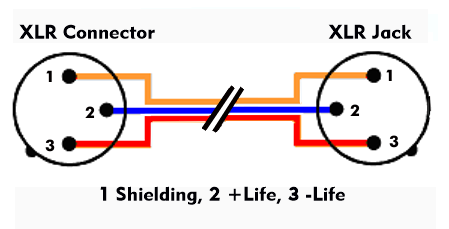microphone cable
Microphone cables are shielded balanced cables through which the microphone signal is transmitted to the microphone preamplifier. In addition to the two balanced lines, microphone cables have a ground line as a third line, which is routed through the shielding. The lines are surrounded by a dielectric, the shielding and the cable jacket made of polyvinyl chloride( PVC).
Since microphones produce extremely low levels, they must be protected from high and low frequency sources of interference. Such sources of interference include lighting systems, power supplies or transmitters. Therefore, an important aspect of microphone cables is their shielding, which can be designed as double braided shielding to avoid electromagnetic interference. The shielding factor can be 80 dB or more for double braided shielding with high coverage. Also included in the shielding are the plugs, with the XLR plug normally used, and the jack plug in less expensive designs. Another aspect for the selection of microphone cables is the impact sound sensitivity. This produces a rustling sound when the microphone cable is moved. Other points are flexibility, tensile strength and bending radius.
As far as transmission characteristics are concerned, these only have an audible effect on the sound if the cable length is long enough for the cutoff frequency to limit the high tones. The impedance is 100 ohms to 200 ohms and the insulation resistance is >1 giga-ohm/km. The shielding used is spiral and/or braided shielding with coverage greater than 95% and/or double-sided, metalized polyester film. Cable diameters are about 6 mm to 7 mm.
Lavalier microphones use the 4- pin TRS microphone plug, a jack plug. TRS stands for Tip, Ring, Sleeve.

